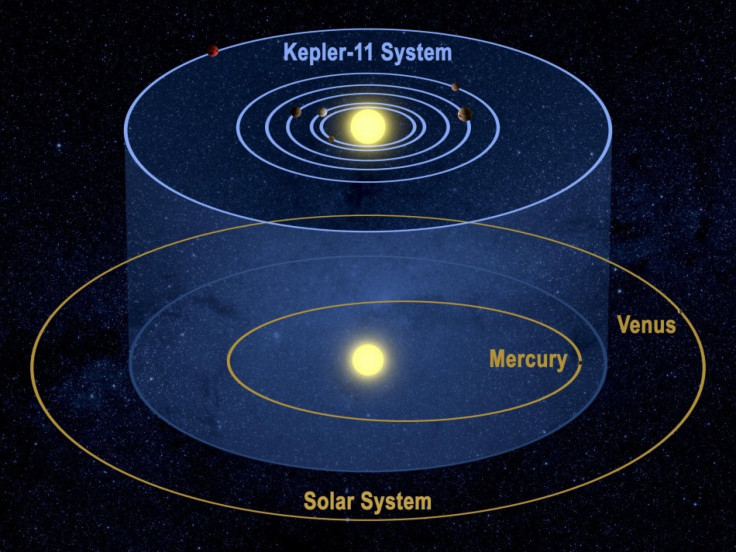Kepler Space Telescope Picks Up Six-Planet System

NASA's Kepler space telescope has picked up multiple planets in a system with a star much like the sun, the largest group of transiting planets yet discovered.
The system is very different from the one we call home. The star, about 2,000 light years away, is very much like the sun, but the planets around are in fast, tight orbits. One takes as little as ten days. Five of the six are closer to their sun than Mercury is to ours.
One of the most surprising things about the system is that it is stable at all, says Jack Lissauer, a co-investigator for the Kepler Mission at NASA's Ames Research Center. For that many planets to be crammed into a small radius the orbits have to be nearly circular, and they have to have just the right distance from each other.
This is why I was so surprised, he said. There were so many planets so close in.
Many of the solar systems discovered have been the homes of Jupiter-sized planets in eccentric orbits. Those types of systems are much easier to see, because a big planet's effects on the parent star are more visible. Kepler is designed to seek out planets closer in size and mass to Earth.
Thus far Kepler has had one big success - in January NASA confirmed it had found the first rocky planet outside our solar system. It is 4.6 times as massive as Earth and has a surface temperature approaching 2,500 degrees Fahrenheit, and like the most recent crop of planets, orbits close to its star.
In this case, Kepler found six planets, all of them transiting the face of the star, called Kepler-11. The planets, in order of their distance from the star, are Kepler-11b, 11c, 11d, 11e, 11f and 11g. Kepler 11b is at about 9 million miles from its sun. The outermost one is on the order of 45 million miles out.
The sizes of the planets around Kepler-11 range from 1.97 to 4.5 times the radius of Earth. The largest are comparable in size to Uranus and Neptune, which means they probably have a lot of hydrogen and helium, Lissauer said. Their heavy gravity allows them to keep those gases in their atmospheres for a relatively long period.
The smaller planets, Lissauer says, are denser, and could have a mixture of rock and water. But the water wouldn't be like an ocean on Earth. Without any other gases in the atmosphere, the water would vaporize and become the atmosphere. Descending onto one of those worlds would be like falling into a cloud that got thicker and thicker until it became liquid. At a certain point one might hit the core of the planet, which could be solid or molten, or the pressure could get so high that the water would solidify. But we don't really know if any of them has any water, Lissauer said.
Whether a planet retains an atmosphere at all depends on the surface temperature and the gravity, Lissauer says. In our own solar system, a planet like Mercury can't hold an atmosphere very long because it gets blasted by the sun's heat and any gases (and most liquids) boil off and get blown away by the solar wind.
In the Kepler-11 system, the fact that the planets are heavier would mean they can hold an atmosphere longer. Lissauer says the only ones they are reasonably sure about are the largest two, which given their diameters and masses would have to have retained a lot of hydrogen and helium.
For Kepler 11's planets, the surface temperatures would be between 1,400 degrees and 1,100 degrees Fahrenheit, assuming they had no atmosphere at all. (Venus, by comparison, has a very thick atmosphere and maintains a surface temperature of 860 degrees F, while Mercury, which is airless, gets to about 750 F at noon).
Scientists can learn so much about the system because of the way Kepler finds planets. When a planet transits across the face of its star, the light dips slightly. The size of the planet can be deduced from how the brightness changes, and by observing over several months one can estimate the period of its orbit. That gives a good estimate of the planets mass.
Lissauer says the team poring over the data will keep looking for evidence of more planets. He notes that the telescope can only see a small portion of the sky, and even then, only those planetary systems that are facing edge-on towards Earth. That means there are many more that Kepler can't see.
Thus far more than 1,200 candidates for planets have been found. About 68 of them are Earth-sized, with a fraction of those in the habitable zone of their stars, the distance at which liquid water can exist.
Kepler won't be the last mission like this. Kepler only looks at a relatively small part of the sky, centered on the constellations Cygnus and Lyra. Lissauer says he has a proposal in for another mission, one that will survey the whole sky, using better camera technology (Kepler was designed a decade ago). While that one won't be quite as sensitive as Kepler is, it will do a better job of finding systems closer to us as it will look at a wider area. He hopes to get it launched about five years from now.
To contact the reporter responsible for this story call (646) 461 6917 or email j.emspak@ibtimes.com.
© Copyright IBTimes 2024. All rights reserved.











